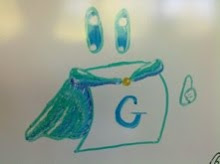So much fun, in fact, that it was time to make a game out of it. The plan is to move from one number in a Collatz sequence to another "neighboring" integer, and be the player to reach the number 1. Obviously, the game gets boring if players always have to choose the next number in the sequence, so we let people go "backwards".
As a quick review, the Collatz Conjecture states that the following process will terminate, starting with any positive number. First, check if the number is 1. If so, stop. Otherwise, check the parity of the number. If it's even, divide it by two and start over. If it's odd, instead multiply it by 3, then add 1 and start over. It's not known whether this is actually true for all numbers, but it's been tested up through something astronomical (and continues to be tested for higher numbers).
For the game, we need to be a bit less strict about what the next number is. Instead of always going "forward" we will allow some backwards moves. So, if on your turn the current number is n, you get one of the following options:
- Move to 2n
- Move to 3n + 1
- Move to n/2, if n is even
- Move to (n-1)/3, if n-1 is divisible by 3
Also, to prevent boring back-and-forth strategies, you are not allowed to just reverse the last player's move. Thus, each turn, there are between 1 and 3 possible moves. For many cases, your next move is decided for you.
Last weekend, my brand-new aide, Ernie, and I gave this a shot, and we quickly realized we needed restrictions on when a player could make either of the moves that increase the current value. After a few rules changes, we both realized that players should be forced to move downwards if possible.
On our first try with these rules, played the following game: 11, 34, 17, 52, 26, 13, 4, 1 (a win for the first player!). In this case, only the first move and the last move actually were decision-making points. Curious, we looked at what happened making the other move from 11:
11 -> 22 -> 7 -> 2 -> 1 (second player wins) which didn't have any other decisions available.
This seems like a boring game, until we tried starting at 10: (D's indicate places where decisions were made)
10 D-> 3 -> 6 D->12 D->37 D->74 D->148 ->49 ->16 D->8 ->4 D->1
Then 16:
16 D->5 -> 10 -> 3 ->6 D->12 D->24 D->48 D->145 D->436 ->218 -> 109 -> 36 -> 18 -> 9 -> 28 ->14->7->2->1
Some of the rules need to be ironed out here to prevent the number from getting too big too quickly. We wound up adding a stipulation that the number can't be doubled three times in a row helping enforce that the number will drop at some point. It could be that other additions help out, without completely limiting player choices.
As it is, this is a nice impartial game to play that requires only a pen and paper and some basic arithmetic. Also, it's likely okay to ignore determining the computational complexity when it's still not known whether all Collatz sequences terminate. Give it a try, and let me know which rules worked for you!



No comments:
Post a Comment